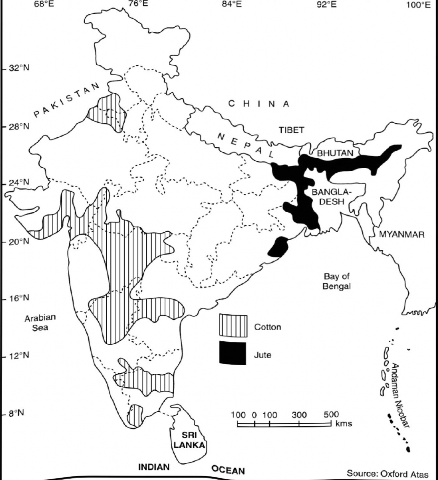COTTON TEXTILE INDUSTRY
Textile industry includes cotton, jute, wool, silk, and synthetic fibre textiles. India is one of the leading producers of textile goods. It is one of the largest and most important sector in the economy in terms of output, foreign exchange earning, and employment in India. Ils contribution! forms 20 per cent of the industrial production, 10 per cent of the excise collection, 18 per cent of employment in the industrial sector, 20 per cent of the country’s total export earning and 4 per cent of the GDP. At present, India is the Z/zzn/large st producer of silk, fifth largest producer of synthetic fibres, and has the largest loomage and spindles in the world.
India enjoyed monopoly in the production of textile goods from 1500 BC to 1500 AD. Indian cotton and silk textiles were in great demand all over the world. It was the arrival of the British in India and the Industrial Revolution in Britain in 1779 which led to the downfall of the Indian manufacturing. The British after the consolidation of their rule in India encouraged the export of raw material from India to Britain and import of manufactured goods from Britain to India. The first textile mill was established in 1854 in Mumbai by C.N. Dewar. The fast growth of cotton textile occurred in 1870 when there was much demand of Indian goods in the wake of American Civil War. Before the First World War the number of Indian textile mills rose to 271. The demand for cloth during the Second World War led to further progress of the textile industry.
The industry suffered a setback in 1947 as good quality cotton growing area went to Pakistan. Consequently, India had to import cotton from the African countries.
Cotton being a pure raw material provides a chance to establish textile mill either in the areas of raw material or in the market. In India, most of the textile mills are in the cotton growing areas or in the neighbouring cities and towns. The location of cotton textile industry is mainly affected by: (i) raw material, (ii) proximity to market, (iii) moist weather, (iv) capital, (v) skilled and cheap labour, (vi) transport, (vii) sea-port, (viii) export facility and the domestic and international markets. The trend of growth in cotton textile industry has been given in Table 11.1.
Year | Cotton cloth (million sq. metres) |
1950-51 1960-61 1970-71 1980-81 1990-91 2000-01 2005-06 | 4215 6738 7602 8368 15,431 19,718 19,250 |
Source: Economic Survey 2005-06.
1-----------------------------------1-----------------------------------1-----------------------------------1-----------------------------------1--1 r

Fig. 11.1 Concentration of Cotton & Jute (2009-2010)
(i) Cotton mills and factories: In the earlier days of its development, mills were the main producers of cotton goods. For example, in 1950-51 over 80 per cent of the total cotton goods production was from the mills and factories, which dropped to only about 10 per cent in 2005-06. The production and employment is increasing steadily in the powerloom sector.
(ii) Powerlooms: The decentralised power-loom sector played a vital role in meeting the clothing needs of the country. The powerloom industry produces a wide variety of cloth with intricate designs and accounts for almost 83 per cent of the total cloth production.
(iii) Handlooms: The handloom sector provides over 12 per cent of the total production.
Most of the cotton mills and factories are located in the cotton producing regions of the country. The main cotton producing areas of the country have been shown in Fig. 11.1.
